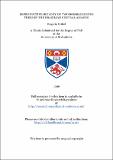Files in this item
Reproductive biology of two bombacaceous trees in the Brazilian Central Amazon
Item metadata
| dc.contributor.advisor | Gibbs, Peter Edward | |
| dc.contributor.author | Gribel, Rogerio | |
| dc.coverage.spatial | xii, 185 p. | en_US |
| dc.date.accessioned | 2018-06-15T14:00:02Z | |
| dc.date.available | 2018-06-15T14:00:02Z | |
| dc.date.issued | 1996 | |
| dc.identifier.uri | https://hdl.handle.net/10023/14127 | |
| dc.description.abstract | Studies were carried out on the reproductive biology of two bombacaceous trees (Pseudobombax munguba and Ceiba pentandra) which occur in the seasonally flooded areas of the white-water river basins ('varzea') in the Amazon region. The unique pollinator of P. munguba, which has nectarless flowers, is the large-sized phyllostomid bat Phyllostomus hastatus. In contrast, the flowers of C. pentandra are visited by a wide range of nocturnal (bats, marsupials, night-monkeys, hawk moths) and diurnal (bees, wasps, hummingbirds) animals, but only the phyllostomid bats, especially Phyllostomus hastatus and Phyllostomus discolor, play a relevant role in the pollination of this mass-flowering species. Both species appear to be self-incompatible since hand self-pollinated flowers always abscised 5-8 days after pollination, whereas a proportion of cross-pollinated flowers (20-29% in P. munguba; 17% in C. pentandra) formed fruit. However, analysis of fixed pistils using fluorescence microscopy revealed that in both species the self-pollen germinated normally on the stigma and the self-pollen tubes penetrated the ovules at the same rate as the cross-pollen tubes. Mixed-pollinated flowers (self- plus cross-pollen on the stigma) also set some fruits (9-14% in P. munguba; 9% in C. pentandra). Paternity analyses using isozyme genetic markers indicated that fruits resulting from controlled mixed-pollinations set a few selfed seeds (range of 0-28% in P. munguba; ca 2% in the studied tree of C. pentandra). The multilocus estimate of the outcrossing rate (tm) was calculated for P. munguba using data from two isozyme loci of 29 parent trees and 728 progenies. The population outcrossing estimation was high (tm = 0.948) suggesting that the breeding population is large and the level of inbreeding (both uniparental and biparental) is very low. The proportion of selfed-seeds produced by two neighbouring C. pentandra trees, which flowered simultaneously, was estimated using isozyme genetic markers at 9% and 28% respectively. It is considered that a high level of genetic load is the main factor responsible for the self-sterility and the predominant outcrossing mating system observed in both species. The number of lethal equivalents per zygote estimated for each was high: average of 13.8 (minimum 6.4) in the P. munguba population, and 12.3 for the single assessed individual of C. pentandra. | en_US |
| dc.language.iso | en | en_US |
| dc.publisher | University of St Andrews | |
| dc.subject.lcc | QK495.B65G8 | en |
| dc.title | Reproductive biology of two bombacaceous trees in the Brazilian Central Amazon | en_US |
| dc.type | Thesis | en_US |
| dc.contributor.sponsor | British Council | en_US |
| dc.contributor.sponsor | Conselho Nacional de Desenvolvimento Científico e Tecnológico. Ciência sem Fronteiras | en_US |
| dc.type.qualificationlevel | Doctoral | en_US |
| dc.type.qualificationname | PhD Doctor of Philosophy | en_US |
| dc.publisher.institution | The University of St Andrews | en_US |
This item appears in the following Collection(s)
Items in the St Andrews Research Repository are protected by copyright, with all rights reserved, unless otherwise indicated.

